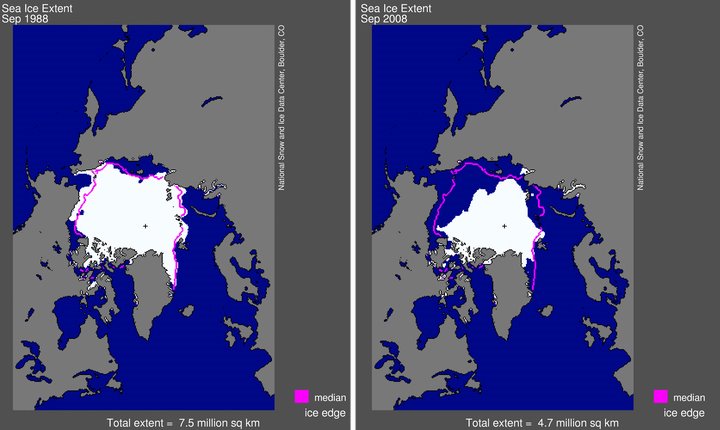
Up until the 1980s, permanent sea ice north of Canada and Russia would have been a substantial barrier to the movement of birds around the Arctic Ocean, inhibiting passage east or west along the northern shores of North America and Siberia. As can be seen in the two images above, however, those barriers have almost entirely disappeared in recent years.
In the late summer seabirds can now range much farther into the Arctic Ocean north of Alaska and Siberia than was possible in the past. In fact by September 2008 there was an ice-free passage along the entire northern coast of Russia and nearly all of Arctic Canada. This must make it easier for birds to travel between the North Pacific and North Atlantic, and may lead to some changes in bird distribution.
So far I can’t point to any pattern of records that are clearly related to the melting of the sea ice, but at least some of the recent increase of species like Slaty-backed and Glaucous-winged Gulls in Europe and eastern North America might involve birds that traveled around the margins of the late summer ice either east or west and then found themselves in the Atlantic. The recent Tufted Puffin in Britain might have been a harbinger of this.
Short-tailed Shearwater also seems like a good candidate to wander widely in the newly-open Arctic Ocean, then head south into the Atlantic. Other birds to watch for include Pacific and Atlantic Northern Fulmar in the wrong ocean. Pacific and Atlantic Common Eiders could also switch oceans, although they have probably found more or less free movement along shore leads for centuries. Only time will tell, but birders in both oceans should be alert for these potential changes.


David,
I ran across this article a few years ago and this post reminded me of it again.
http://www.ncbi.nlm.nih.gov/pmc/articles/PMC240703/
Perhaps the hypothesized timing of extinction of this colony of Short-tailed Albatrosses in Bermuda was such that it wasn’t the interglacial sea level rise that caused the extinction but the subsequent isolation from some critical life history parameter in the North Pacific when the Arctic Ocean began to freeze again.
Maybe some of the birds that might be expected to begin to arrive in the Atlantic (again) are the North Pacific albatrosses.
Hi John, Interesting thought! Short-tailed Albatross has been recorded in the Arctic Ocean historically (more than the other Pacific albatrosses), so one certainly could wander into the Atlantic.